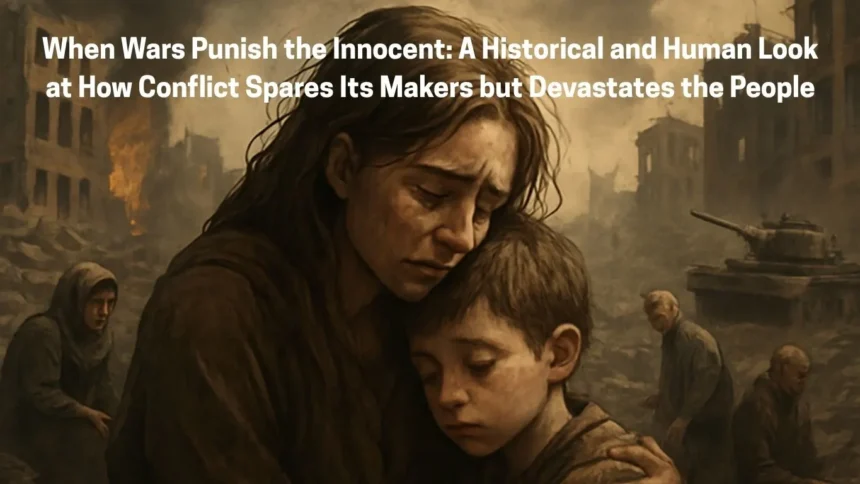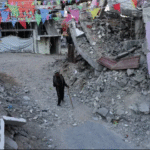Introduction – The Pattern That Never Ends
Wars usually come to the headlines into the spotlight’s unexpected event. They seem to be a cross between a breaking news story, a military press release and a flash of gunfire on a grainy piece of video. However, in reality wars do not spring up overnight as they are the emergence of a political decision, military strategy and pressuring tensions. The real front line or ordinary human cost of war also takes form in neighborhoods, public markets and village streets, whereas the decision-makers can be seen in their palaces, secure bunkers or parliament halls.
It would be known since 70 C.E. in Jerusalem, then again, sorrowfully, in 2022 in Mariupol: war is not nice to its creators, like to its humble pedestrians. Political leaders, military leaders or economic elites are usually encapsulated in distance, wealth, and diplomatic immunity. The ones that have to bury their loved ones, lose their homes, and live with the scars are the civilian people that neither planned or declared the war.
Technology might have changed the course of fighting wars, but the reality of the matter is not lost. In this piece, I examine the history of civilian casualties in war, why it has not stopped and how it has been experienced in various wars across centuries and continents in a long, unflinching look. On the way, we will get to the call of the survivors, data, and face a stark truth: wars can be initiated by those in command but the weak have to fight it.
Ancient and Medieval Conflicts – Civilians as Strategic Targets
Long before the phrase of the collateral damage became part of political language, armies knew that civilians were a weapon as much as were soldiers. Old wars were usually not just about crushing an enemy army but were also intended to extinguish the spirit of fighting among the population.
Siege of Jerusalem (70 AD)
Titus, legions of Rome, Jewish uprising in 70s Benkilasi revolt of the Jews resulted in frenzy over Jerusalem. The siege lasted several months and denied food and water. Researchers of ancient society, historian Josephus, documented the incidence of starvation to an extent that families began fighting against each other. Most of the population were persecuted or enslaved upon capture. The devastation of the Second Temple not only redefined Jewish history but it tore up a generation.
Baghdadi looting (1258)
Hulagu Khan led the Mongols in their Middle Ages conquest of Baghdad, which was one of the deadliest civilian massacres that there was in human history. It destroyed the city which became a hub of science, culture and trade and burned the city libraries and estimates of civilian casualties vary between 200,000 and more than a million. This devastation was absolute and it would require centuries before Baghdad could regain its stature as a world center of intellect.
Hundred years war (November 1337-1453) War starvation
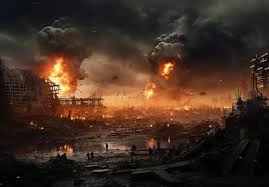
The war between France and England was not held solely on battle fields– it plowed under crops, interrupted commerce and brought countryside people to the brink of starvation. Combined with the Black Death which travelled over laid down trade and migration arteries, civilians were subjected to war and plague, and offered very little defense against either.
Colonial Era Wars – Resources Over Lives
The colonial conflicts were not necessarily wars in the conventional sense; the conflict most of the time was an economic campaign that was dutifully enforced through military force and citizens were laborers as well as the victims.
Anglo Zulu War (1879)
It is usually shown as a military battle between the British Empire and the Zulu Kingdom, but the civilian casualty was enormous. The Zulu reaction by the British was initially successful resulting in the scorched earth process of burning villages and livestock often being the main staple of the Zulu people, only to be taken away by the British. There were thousands who lost their lives because of hunger and displacement.
Indian Revolt of 1857
In British memory, it was known as the Sepoy Mutiny and in Indian Revolt as the First War of Independence, but fierce fighting was accompanied by widespread civilian reprisals. Towns under suspicion of harboring rebels were destroyed, and civilians tried by and then executed by violence. This was followed by a famine in various regions because agricultural patterns were put out of path.
Herero and Nama genocide (1904-1908)
This killing spree was a reaction to the attempts of the German colonialists to resist the local resistance that were set in modern-day Namibia. The civilians were forced to the desert, where they poisoned or put under guard the water sources. Historians deem this as among the earliest mass killings of the 20th century, and tens of thousands of Herero and Nama were killed.
Industrial Age Wars – Total Societies in Conflict
With the industrial age came not just new arms, but new ways of warfare- whole economies and societies were mustered into service of war and the non-combatant civilian was the most important battlefield participant.
World War I The Armenian Genocide
- During the first world war the number of Armenians deported and killed by the Ottoman Empire was up to 1.5 million. Death marches on civilians, villages were cleared. The genocide was also perpetrated with military campaigns and war was the alibi and the excuse.
World War 2 -The Cities as the Lead Targets
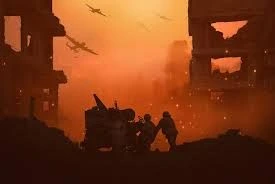
- During the Blitz (1940-1941) London was bombed during 57 consecutive nights and more than 43,000 civilians lost their lives.
- Firebombing of Dresden (1945) reduced the city to ashes and an estimated 25,000 people (mainly women, children and the elderly) died.
- The bombing of Tokyo (March 1945) resulted in civil deaths numbering more than 100,000 in a one night operation.
- In Hiroshima and Nagasaki (August 1945) 129,000-226,000 people were killed, most of them civilians, and the effects of the radiation exposures would be felt in the long-term.
Cold War Era Conflicts – Proxy Wars, Real People
Although the countries of the U.S. and USSR seldom fought directly one against another, their proxy wars destroyed the civilian population all around the world.
Vietnam War (1955-1975)
When in 1968 conveyed the brutality of civilians in My Lai were observed the emblem of the weak. In only several hours, U.S troops killed over 500 unarmed villagers. Napalm and Agent Orange destroyed farmlands and health emergencies became an unending phenomenon.
Soviet–Afghan War (1979–1989)
People in the countryside were the target of Soviet bombing campaigns. More than 5 million Afghan people abandoned their country, which led to one of the biggest crises of refugees of that period.
Korean War (1950-1953)
It led to murder or expulsion of millions of civilians. The boundaries of the war repeatedly changed and people were being re-settled, evacuated and made to fight.
Post-1990 Conflicts – Technology and Trauma
Rwanda Genocide (1994)
Tutsis and some moderate Hutus were killed, with an estimated 800,000 people massacred in only 100 days, usually using a machete. People were demographically cleared off the map, not with the high-tech war, but organized brutality on civilians.
Bosnia and Kosovo (90s)
Ethnic cleansing campaigns were carried out involving expulsion, detention, or killing of people. The Siege of Sarajevo was about four years and citizens were bombarded everyday by shells and snipers.
Iraq War (2003-2011)
Although technically a war against the regime of Saddam Hussein, it was a brutal fighting in urban centers such as Fallujah and Baghdad that resulted in the death of thousands of civilians and a destruction of infrastructure.
Gaza, Aleppo, Mariupol – The Urban Traps of the 21st Century
Gaza
A number of wars fought between Israel and Hamas have led to the deaths of civilians in the hundreds and thousands. UN reports portray attacks on homes, schools and hospitals in spite of international demonstrations to protect lives.
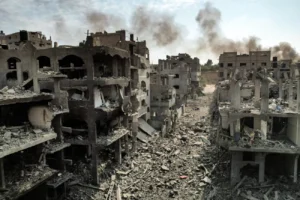
Aleppo (2012–2016)
Aleppo, once the largest city in Syria, was turned into a symbol of city hostilities. Thousands were killed through barrel bombs, artillery and starvation sieges. There were numerous attacks on hospitals and doctors had to work in basements.
Mariupol (2022)
People who stayed in the besieged city of Mariupol were weeks without water, electricity, and medical care as they were bombed by Russians. Mass graves were detected on satellite pictures and the UN put the number of civilian victims in the thousands.
Eyewitness to Survival – Voices from the Ruins
A Syrian Doctor in Aleppo:
“We performed surgeries by phone light. I saw children die because we had no anesthesia left. War isn’t only bullets—it’s the absence of everything you need to live.”
A Gazan Teacher (2023):
“My students stopped drawing flowers and started drawing tanks. That’s how I knew the war had taken more than buildings—it had taken childhood.”
A Ukrainian Grandmother in Kharkiv (2022):
“I buried my husband in the garden because the cemetery was under fire. We had to mark the grave with a chair so I could find it later.”
Economic Winners – The Profiteers of War
There has always been a deep economic profitability of war to powerful business corporations, industries, and individuals in general- not those directly on the front line soldiering, but all those at the periphery. According to recent SIPRI data, the worldwide arms trade was estimated to be at least 138 billion dollars in 2022-with an inconsistency in reporting it was conservatively estimated, the actual total amount is probably higher.
America accounts for 43% of international armed exports worldwide, 2020-2024, followed by France and Russia with about 9-10% respectively Statista SIPRI. Regarding recipients, between 2019 and 2023 the biggest importers were India, Saudi Arabia, Qatar, Ukraine and Pakistan SIPRI.
Private military contractors and war companies are big profiteers:
- Halliburton, including the subsidiary KBR, was awarded more than 39.5 billion in federal contracts related to the Iraq War – Wikipedia.
- Through contracts awarded by the State Department, Blackwater raked in more than 320 million dollars to provide protection to U.S. employees in Iraq.
- DynCorp was audited on corruption with regard to the mismanagement of said funds in the conflict worth 1.3 billion in contracts, including unauthorized expenses in the form of an Olympic-sized swimming pool to train Iraqi policemen.
- Outsourced warfare is illustrated as thousands of the authoritative warfare in Iraq was given out by Aegis Defence Services headed by Tim Spicer with a Pentagon contract worth 293 million dollars.
- TransDigm was found to be billing the Pentagon as much as 9,400% on parts and the case dragged through congress and courts demanding refunds.
- In modern hybrid warfare, the Russian Wagner Group monetized conflicts by trading military support for mining rights in Africa—smuggling out over $2.5 billion in “blood gold” to fund operations in Ukraine and beyond.
Laws vs. Reality – International Law Under Siege
The international humanitarian law is primarily meant to safeguard civilians and punish war crimes with the Geneva Conventions being one of them. The difference between law and enforcement is however immense.
An example includes the Israel Hamas war where about 9,200 Gazans and 1400 Israelis died; the United Nations are also investigating war efforts of both parties on either side of any violation including collective punishment and attacks on medical facilities.
In Gaza and other conflict zones, hospitals, aid workers, and medical convoys are increasingly targeted, a phenomenon termed “healthocide.” The number of attacks on healthcare services recorded in 2024 exceeded 3,600 cases, of which 986 healthcare workers were killed in Gaza, and 217 in Lebanon due to the same crisis.
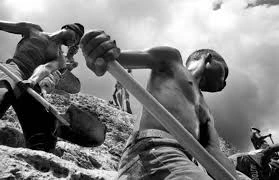
Regardless of laws being in place, the actual enforceability relies on political leverages and accountability and, in the case of powerful states, accountability may be lacking. The prosecutions of crimes which occurred as a result of state-aligned groups or proxy are also rare and there are moments when international agencies have no ability to act effectively.
Is Civilian Protection Possible?
Rare successes such as humanitarian corridors, negotiated evacuation and safe zones are demonstrated but soon cut short:
-
In eastern Aleppo (2016), corridors briefly allowed civilians to escape siege, but the agreement soon collapsed under renewed shelling and broken promises.
-
UN peacekeepers in conflict zones can offer a buffer, but limited mandates, insufficient troop numbers, or political obstruction severely restrict their effectiveness.
-
Safe zones may be designated, but without air superiority or strong backing, they often become legal but not physical sanctuaries.
Therefore, even in the circumstances of legal and logistic machinery protection of the civilians is the exception, weak and easy to shatter when the time comes.
Memory, Forgetting, and the Next War
The lesson of history is that people are dedicated to the memory of the authority of the victims of war often glorified in monuments but never their errors.
World War I was called the “war to end all wars”. But twenty years later, the world has been entangled in an even greater deadly global war. Nevertheless, countries are unable to internalize the lesson during the memoirs, memorials, and peace education, and the history of tragedies resurges with third generations.
Summary Table
| Section | Key Expanded Details |
| Economic Winners | Arms trade scale, country shares, profiteering firms, PMC scandal examples |
| Laws vs. Reality | Geneva Convention violations, healthocide data, enforcement limitations |
| Protection of Civilians | Examples of corridors, UN limitations, rarity of sustained protection |
| Memory & Next War | Memorialization vs. recurring patterns; missed lessons of past global conflicts |
Conclusion: Rewriting the War Story
History has told us that. War has never been an implement of weakness, and it is seldom the designer thereof who wakes and runs in terror to the sound of shells overhead, who rations his water, or is called to bury his brains. The expansiveness of human conflict brings one trend to the fore with acute soreness. Movements in motion are caused by political determinations and calculations of strategy, but the toll in human lives, houses, livelihoods and futures is incurred in body and spirit. That burden falls especially heavily on civilians, who far too often enter the discussion on policy too late in proceedings and are soon forgotten in the news.
This does not mean that the trend cannot be avoided. It implies that it takes a deliberate design and not optimism to change it. Relocation of institutions, laws and the expectations of the people to a more realistic view of civilian protection, and civilian recovery is where the real change will transpire as opposed to the rhetoric of victory. The roadmap below details practical actions that, combined, would provide an alternative to the international community, state, military, media, and civil society response to conflict.
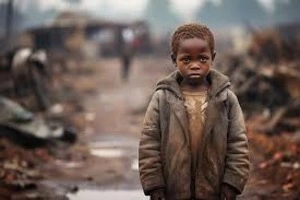
Increase preventative diplomacy and early response
Early warning systems and also mediation capacity need to be invested by governments and regional organizations. Strong, quick diplomacy makes it less likely that local conflicts can evolve. Professionalized mediation teams, track two diplomacy, and/or incentives to negotiate de-escalation would be low-cost, realistic measures that avoid future disaster.
Recreate global systems of responsibility and rapid investigation
International law can be considered important, yet it needs to be properly implemented. States ought to fund autonomous rapid deployment investigation groups ready to report damage to the civilian population as close to real time as achievable. Such units are expected to have the authority to report results in a timely manner as well as provide evidence that can be used in subsequent legal proceedings. By enhancing war-crimes tribunals, along with greater cooperation with the International Criminal Court, the chances will rise that those who commit them will be called to answer. To decrease the capacity of influential states to veto effective accountability mechanisms in multilateral arenas political reforms are necessitated.
Weapon sales and military outsourcing ought to be publicized and made conditional
The economic factors maintaining the conflicts should be dealt with. States ought to accept legally binding rules of transparency on arms transfers and on military contracting. Licences to export should be made conditional on provably employing protection of civilians and the use of post-conflict audits. Enforceable compliance regimes must be established to control the activities of private military contractors and reconstruction firms where they will be penalized in case of abuse and corruption. In areas where reconstruction funds are administered, human security results should be the top priority with respect to conditionality which includes access to health, education, and housing.
- Recast military doctrine around civilian protection and verification
All militaries should integrate civilian protection metrics into operational planning. Rules of engagement must prioritize the preservation of life and infrastructure, and commanders at all levels should be accountable for civilian harm under national and international law. Investment in non-lethal conflict-mitigation tools, population warning systems, and verified humanitarian pauses can reduce casualties. Where safe corridors or zones are agreed, they must be backed by clear, enforceable guarantees and monitored by independent observers.
- Rebuild a humanitarian architecture that is resilient and rights-based
Humanitarian response needs faster, more flexible funding, and better protection for civilians who remain in conflict zones. Donors should increase direct funding for mental health services, education continuity programs, and small-scale local reconstruction that restores livelihoods. Legal protections for refugees and displaced persons must be enforced consistently, with international burden-sharing that avoids leaving entire regions to shoulder the cost alone.
- Transform how the media report on war
Newsrooms should shift emphasis from a narrow focus on military maneuvers to consistent coverage of civilian impacts. This requires resources for local journalism, protections for reporters on the ground, and editorial standards that demand verification of civilian casualty claims. International outlets can amplify local voices and ensure that human stories remain central, not peripheral, to the record of conflict.
- Make memory an institutionalized prevention and learning tool
Memorial should go beyond commemorating the dead. The schools must be educated about the real life price of war and the text book lesson of past failures in the war. Memorialization projects may be combined with civic learning and scholarships and vocational training of the children of conflict. This kind of memory is not a mourning exercise alone; but an investment in a future citizenry who know the stakes involved, and would like leaders to make other policy decisions.
- Activate civic pressure and economic leverage in order to be accountable
Policy can be changed by the use of market instruments by the citizens and the civil society. Consumer pressure on companies, divestment campaigns, and specific demands of transparency can render it politically expensive to any company and, indeed, institution(s) to continue to profit in the context of an ongoing conflict. Military budget allows independent audit and parliamentary oversight that decreases footprints of corruption and closes national budgets with human security values.
- A long-term recovery must be a top priority of any peace strategy
A lack of shooting is not peace. It needs restoration which gives back the dignity and chance. The reconstruction plans to be set up by donors and governments should be targeted towards housing, health infrastructure, schools, and employment. By investing in these sectors, the risk of the re-emption of violence is less likely and populations displaced are able to re-establish stable life.
And now something about moral responsibility. These are morally irresistible reforms, but even pragmatic ones. Assisting civilians minimizes the expenses in the long run. It decreases the outflow of refugees, limits economic meltdown, and ensures the retention of human capital in order to capture post-conflict regeneration. It will mean a more stable world, a greater prosperous world and a more just world because there will be less harm to collectives of human beings that we call civilians. It will not be easy to change the incentives to go to war. This will require political leaning and international cooperation. It must have a nation that desires more; it must have a journalism that does not smile to dismiss the sufferings of non-fighters as a postscript.
For The Vue Times and for readers everywhere, the task is twofold. First, keep telling the human stories that reveal the true cost of conflict. Second, insist that the conversations about war include concrete plans to protect civilians before, during, and after fighting. If the architects of war will not change their calculus on their own, then public pressure, informed policy, and smarter institutions must change it for them.
History is not predetermined of the future. Our failures with civilians are demonstrated in the history of the past millennia. It demonstrates, as well, that there is a way to make significant change happen when societies decide to work toward their ultimate value: humanity and dignity. It is up to this conversation we start today, and policies we construct tomorrow, to ensure the next generation is not passed another set of ruins, but another, safer world.

